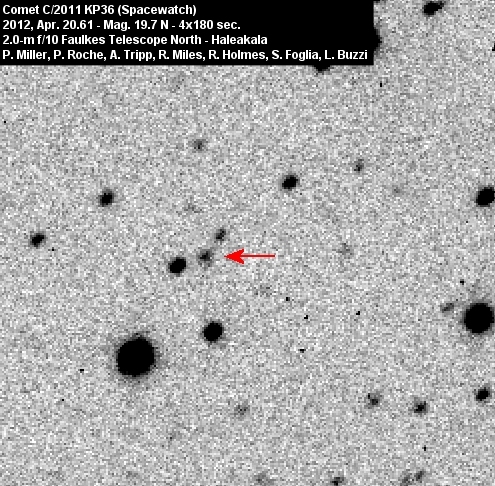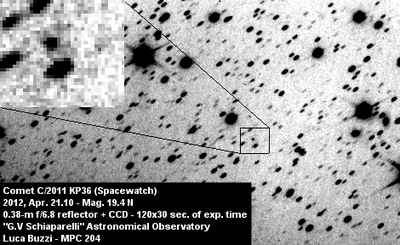Discovery of cometary appearance of 2011 KP36
During observations of NEO 1998 OK1 with the 0.81-m f/4 of ARI Observatory (Westfield, code H21) on Apr. 19 Tomas Vorobjov serendipitously detected also 2011 KP36 in the same FOV. Stacking all the images together (totalling 30 minutes) with its proper motion vector, Tomas Vorobjov firstly noted its cometary appearance, with a coma 6″ wide and a possible tail 9″ long in PA around 10°. Its FWHM was 4.4″ while stars nearby were 3.5″.
After his alert, Sergio Foglia and myself observed it the following day with the 2.0-m f/10 Faulkes Telescope North at Haleakala. Conditions were nearly the best possible and stacking 4×180 seconds images its cometary activity was quite clear. FWHM was 1.3″ while stars 1.1″, but the real confirmation was the presence (visually) of a round faint coma at least 7″ wide.

On Apr. 21, under good seeing conditions I obtained 60×30 seconds images with the 0.38-m f/6.8 reflector from Schiaparelli Observatory: its faint coma was visible for 13″ wide even if its FWHM was only 10% larger than stars nearby (3.7″ vs 3.4″).
Another confirmation came from Tomas Vorobjov using th RCT 1.3-m f/13 from Western Kentucky University located at Kitt Peak (diffuse object with a 8″ coma and a hint of tail in p.a. 80 deg).
Discovery was announced on CBET 3109 on May 17, together with the orbital elements on MPEC 2012-K12.
By Luca Buzzi
